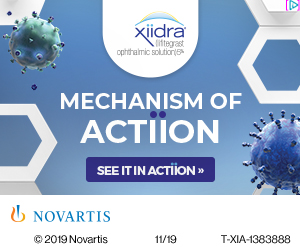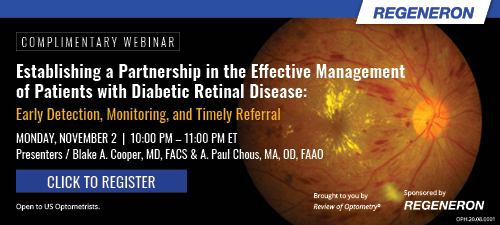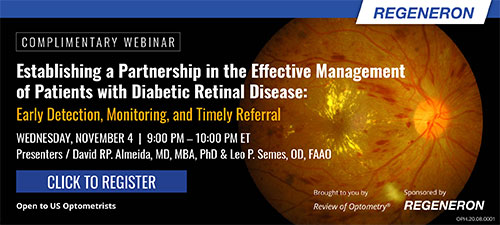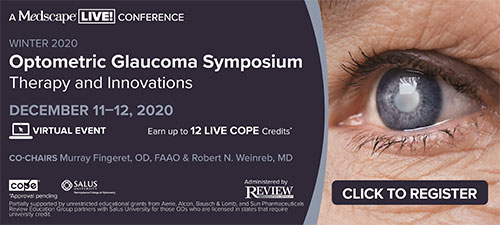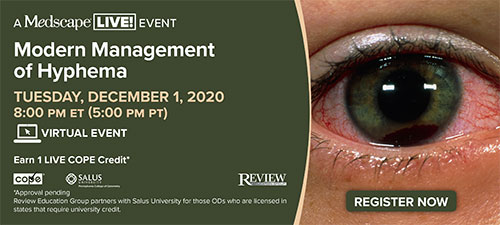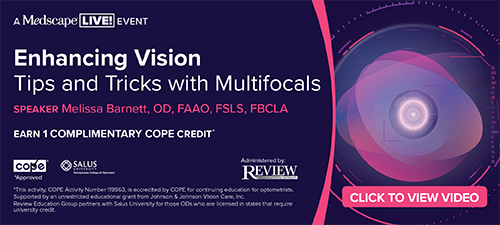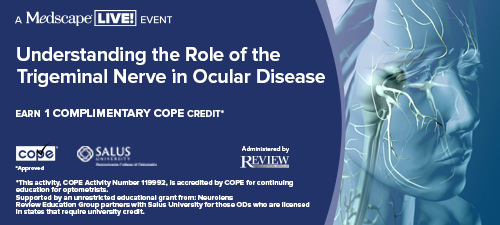
A
weekly e-journal by Art Epstein, OD, FAAO
Off the Cuff: Talulah
Although I always have a lot of things to say about optometry, this week I find myself unable. Those of you who are long-time readers or have become friends over the years will understand.
|
||||||||
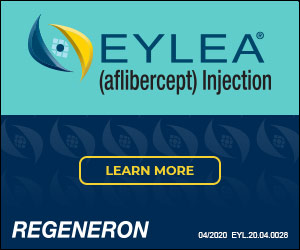 |
||
| Glaucoma As a Prognostic Factor of CRVO: Visual and Anatomical Outcomes and Occurrence of Ischemic CRVO | ||||
These researchers compared the functional and anatomical outcomes of central retinal vein occlusion (CRVO) according to the presence of glaucoma before the onset of CRVO, and assessed whether pre-existing glaucoma affects the prognosis of CRVO in terms of development and conversion to ischemic CRVO. In this retrospective cohort study, patients with treatment-naïve CRVO were enrolled between December 2009 and February 2019. The patients were classified into two groups according to the presence of pre-existing primary open-angle glaucoma at CRVO diagnosis. Researchers reviewed medical records regarding basic demographics, ocular characteristics and treatments. The effects of pre-existing glaucoma on the occurrence of ischemic CRVO were also investigated using Cox proportional hazard models. Of 166 eyes from 166 patients, 26 (15.7%) had pre-existing glaucoma. The pre-existing glaucoma group revealed significantly older (69.4 ± 13.3 vs. 56.5 ± 15.9) and lower BCVA at baseline (1.06 ± 0.75 vs. 0.64 ± 0.58, logMAR) and final visits (1.56 ± 1.35 vs. 0.64 ± 0.48, logMAR) than the non-glaucomatous group. In terms of perfusion status of CRVO, the glaucoma group showed higher incidence of ischemic CRVO (30.8% vs. 5.3%) at initial and last visits as well as more disorganization of retinal inner layers (DRIL) at three months (76.0% vs. 49.6%, p=0.015). Pre-existing glaucoma, lower vision at baseline and DRIL at three months were significant risk factors for the occurrence of ischemic CRVO. |
||||
SOURCE: Kim YN, Shin JW, Park YJ, et al. Glaucoma as a prognostic factor of central retinal vein occlusion: visual and anatomical outcomes and occurrence of ischaemic central retinal vein occlusion. Acta Ophthalmol. 2020; Oct 28. [Epub ahead of print]. |
||||
 |
||
| A New Neutrophil Subset Promotes CNS Neuron Survival and Axon Regeneration | ||||
Transected axons typically fail to regenerate in the central nervous system (CNS), resulting in chronic neurological disability in individuals with traumatic brain or spinal cord injury, glaucoma and ischemia-reperfusion injury of the eye. Although neuroinflammation is often depicted as detrimental, there is growing evidence that alternatively activated, reparative leukocyte subsets and their products can be deployed to improve neurological outcomes.
|
||||
| SOURCE: Sas AR, Carbajal KS, Jerome AD, et al. A new neutrophil subset promotes CNS neuron survival and axon regeneration. Nat Immunol. 2020; Oct 26. [Epub ahead of print]. | ||||
 |
||
| Changes in Metamorphopsia After the Treat-and-extend Regimen of Anti-VEGF Therapy for Macular Edema Associated With BRVO | ||||
This study aimed to investigate the changes in metamorphopsia after administering the treat-and-extend regimen of anti-vascular endothelial growth factor therapy for branch retinal vein occlusion-associated macular edema. Researchers retrospectively examined 27 patients (27 eyes) with macula edema due to branch retinal vein occlusion who received intravitreal injections of anti-vascular endothelial growth factor agents using the treat-and-extend regimen for ≥18 months. They evaluated best-corrected visual acuity, central macular thickness, macular edema recurrence and amount of metamorphopsia, quantified by M-CHARTS. The best-corrected visual acuity (logarithm of minimum angle of resolution) and central macular thickness significantly improved at 18 months compared with baseline: the median value (interquartile range [IQR]), 0.30 (0.15 to 0.52) and 459 (373 to 542) μm at baseline; and 0 (-0.08 to 0.16) and 267 (232 to 306) μm at 18 months. The M-CHARTS score (the mean of vertical and horizontal scores) significantly decreased at one, six and 12 months compared with baseline, but worsened at 18 month: the median value (IQR), 0.45 (0.250 to 0.925), 0.4 (0.15 to 0.70), 0.4 (0.150 to 0.625), 0.4 (0.225 to 0.550) and 0.45 (0.225 to 0.750) at baseline, one month, six months, 12 months and 18 months, respectively. The median cumulative number of macular edema recurrences was two (IQR, 0.5 to 3.0) at 18 months. Simple linear regression and multivariate analyses revealed that the change in the mean M-CHARTS score at 18 months was significantly correlated with the baseline score and the cumulative number of macular edema recurrences. |
||||
| SOURCE: Mori K, Ishikawa K, Wada I, et al. Changes in metamorphopsia after the treat-and-extend regimen of anti-VEGF therapy for macular edema associated with branch retinal vein occlusion. PLoS One. 2020; Oct 28;15(10):e0241343. | ||||
 |
||
| News & Notes | ||||||||
AAOF Announces VSP Practice Excellence Scholarship Recipients
|
||||||||
| Kala Pharmaceuticals Gets FDA Nod for Eysuvis Kala Pharmaceuticals announced the FDA approved Eysuvis (loteprednol etabonate ophthalmic suspension) 0.25% for the short-term (up to two weeks) treatment of the signs and symptoms of dry-eye disease. Eysuvis utilizes Kala’s Ampplify mucus-penetrating particle drug delivery technology to enhance penetration of loteprednol etabonate into target tissue on the ocular surface. The FDA granted approval to Eysuvis based on results from four clinical trials. Kala Pharmaceuticals plans to launch Eysuvis in the US by year-end. Read more.
|
||||||||
| Allergan Announces Positive Topline Results for Investigational Presbyopia Treatment Allergan, an AbbVie company, announced the Phase III GEMINI I and II clinical trials evaluating the efficacy, safety and tolerability of investigational AGN-190584 (pilocarpine 1.25%) ophthalmic solution for the treatment of symptoms associated with presbyopia, met their primary efficacy endpoints. Additional details will serve as the basis for the FDA New Drug Application submission in the first half of 2021. Read more. |
||||||||
| Orasis Initiates Phase III Studies of Novel Eye Drop Candidate for Presbyopia Treatment Orasis Pharmaceuticals announced the initiation of NEAR-1 and NEAR-2 Phase III clinical studies evaluating its novel eye drop candidate designed to improve near vision for people with presbyopia. The NEAR-1 and NEAR-2 Phase III studies are multicenter, double-masked, parallel-group clinical trials in the United STates enrolling approximately 600 participants with presbyopia to further evaluate the efficacy and safety of Orasis’ eye drop candidate. Read more.
|
||||||||
| Aerie Initiates Phase IIb Trial of AR-15512 for DED Treatment Aerie Pharmaceuticals announced the start of COMET-1, a Phase IIb clinical trial of AR-15512 (TRPM8 agonist) ophthalmic solution for the treatment of patients with dry-eye disease. The randomized, double-masked, vehicle-controlled trial is evaluating the efficacy and safety of AR-15512 in patients with dry-eye disease. The primary efficacy endpoints are ocular discomfort (symptom) and tear production (sign). Patients will be evaluated on multiple efficacy assessments at days 14, 28 and 84; safety will be assessed at all visits. Topline results from COMET-1 are expected in the third quarter of 2021. Read more.
|
||||||||
| FDA Accepts Santen’s NDA for Cyclosporine Topical Ophthalmic Emulsion, 0.1% Santen announced that the FDA accepted the New Drug Application for cyclosporine topical ophthalmic emulsion, 0.1% for the treatment of severe vernal keratoconjunctivitis in patients ages four to 18. The FDA set June 26, 2021, as the Prescription Drug User Fee Act goal date. The NDA submission for cyclosporine topical ophthalmic emulsion, 0.1% is supported by data from VEKTIS, a 12-month, randomized, multicenter, double-masked, vehicle-controlled, clinical trial. Read more.
|
||||||||
| Nicox Selects NO-mediated, IOP-lowering Agent as Development Candidate Nicox SA selected a new development candidate, NCX 1728, from its proprietary research program focused on nitric oxide-mediated intraocular pressure-lowering agents. An analog of this molecule demonstrated positive results in ocular hypertensive non-human primates compared with travoprost 0.1%, a prostaglandin analog. Further optimization of the ophthalmic formulations of NCX 1728 will continue prior to initiating formal pre-Investigational New Drug tests required for the filing of an IND application. Read more.
|
||||||||
|
Prevent Blindness Declares November as Diabetes-related Eye Disease Month Prevent Blindness has declared November as Diabetes-related Eye Disease Month. Educational resources available include downloadable factsheets, training modules, social media graphics and more. Materials are available in English and Spanish. View the new toolkit.
|
||||||||
|
||||||||
|
||||||||
|
||||||||
|
Optometric Physician™ (OP) newsletter is owned and published by Dr. Arthur Epstein. It is distributed by the Review Group, a Division of Jobson Medical Information LLC (JMI), 19 Campus Boulevard, Newtown Square, PA 19073. HOW TO ADVERTISE |



